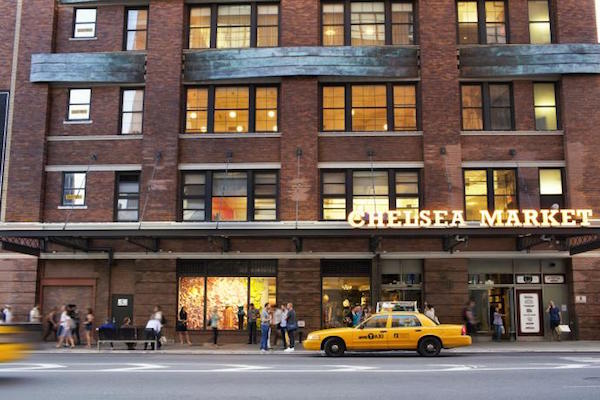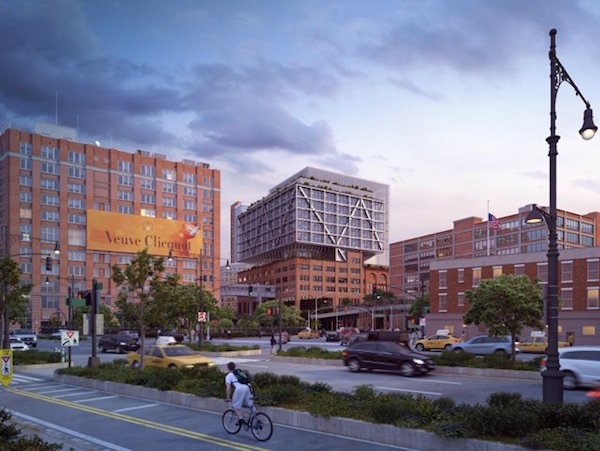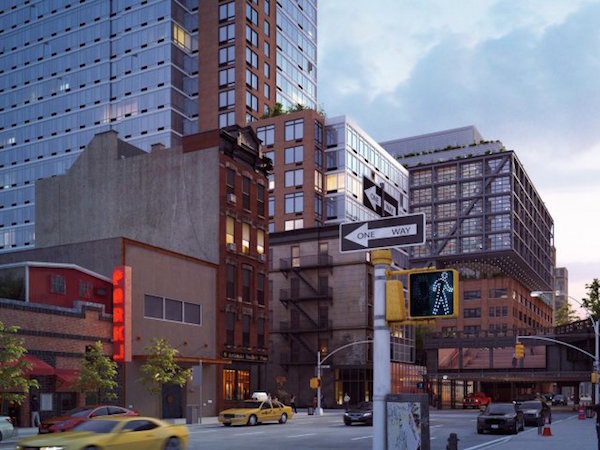
BY WINNIE McCROY | High above and down below, big plans are in the works for Chelsea Market — but the building’s vertical expansion has been delayed, as Jamestown searches for an anchor tenant. The investment and management company did, however, recently announce plans to invest $35–50 million into doubling the size of the food and shopping destination’s retail property space. In the meantime, they are making good on the majority of their promised contributions to the community — made as part of an often contentious, years-long process during which Jamestown asserted that their plans to build atop the existing structure were necessary to meet a projected demand for more tech sector office space.
“The vertical expansion on the west end is not expected for four or five years now. Originally we expected it to start in 2017, but it’s not going to happen that quickly,” said Lee Compton, Co-Chair of the Chelsea Land Use Committee of Community Board 4 (CB4).
In 2012, CB4 approved Jamestown’s plan to add 300,000-square-feet of office space atop Chelsea Market, creating 1,200 long-term jobs and 600 construction jobs. In 2014, STUDIOS Architecture released renderings for this nine-story addition to the west side of the Chelsea Market, known as BLDG 18.
This March, Jamestown President Michael Phillips told Crain’s New York Business. “When we go vertical on the tower, we’ll have new demand,” referring to the expansion of the office space, which will bring additional workers to shop and eat at Chelsea Market. He noted, however, that they won’t begin office expansion until they have secured an anchor tenant for the space.
For now, Jamestown has begun renovating the largely unused lower level of Chelsea Market to create 80,000-square-feet of retail space. They will move several large concourse-level businesses to this basement level, at a price point significantly lower than the $400 per-square-foot ground floor.
“Great retail is organic: It lives and breathes, and you always have to think about how to make it better,” Phillips told Crain’s. “Adding the lower level gives us precious square feet in [a real estate] market where there isn’t a lot of retail like this.”
Jamestown has also begun transforming a boiler room into space for a new restaurant. Phillips told the media his aim is to convert the entire basement level over the next five years, linking it with a central corridor, providing access for shoppers.
“They are already changing the lower level of concourse into retail, and we expect them to move several businesses there, freeing up space on the main level,” said Compton. “The Manhattan Fruit Exchange and Buon Italia are moving downstairs, and a main staircase to the lower level will be built in that space.”
The expectation is that Jamestown will put more retail shopping destinations on the lower level — so those shopping specifically for food will encounter less congestion, as most tourists are expected to stay on the main concourse.
“We are proud to be part of the Chelsea community and are looking forward to expanding the retail space within Chelsea Market, providing local Chelsea residents and guests with more dedicated access to great food and places to shop for hard-to-find ingredients,” a Jamestown spokesperson told Chelsea Now.

When Jamestown initially sought approval, it agreed to a host of concessions, which would support the community. Construction delays have not stopped them from meeting these goals.
Jamestown has made significant financial contributions to at least a dozen projects, including construction and operating funds for the Tech Up computer training program at Hudson Guild; a food worker training program and food incubator space in Long Island City; a $57,000, three-year nutritional program at two local schools; landscaping and displaying public artwork on the concourse; sponsoring Fulton Houses’ holiday party and several $10,000 Thanksgiving turkey giveaways; $100,000 annual contributions to the James Beard Foundation; $1,500 to PS 11’s Annual Gala and $1,000 to the Corlears School; and a $50,000 annual gift to Friends of the High Line.
“They are definitely meeting their good faith efforts. They have proved to be a very good partner and an integral part of the community here,” Compton said. “The only thing I noticed is that the delay in the vertical expansion of the west end delays their contribution to the High Line. They were going to make a financial contribution for its upkeep; that was key to the western vertical expansion. Now the contribution is going to be delayed. But we certainly have the impression that the High Line is doing okay.”

Robert Hammond, Co-Founder and Executive Director of Friends of the High Line, said Jamestown had been a good neighbor, and confirmed that the delay in this contribution would have no significant impact on them.
“They would provide capital construction support, because when that’s built, we’ll be able to create some back-of-house storage space, bathrooms, and community meeting space,” Hammond noted. “So we’ll use those funds for that, as well as the general upkeep of the High Line. The delay doesn’t affect our day-to-day operations, because it wasn’t meant for that.”
Compton invited Phillips to return to CB4 in the fall with an update, as the initial process was met with persistent opposition from many in the community and on the board. But he was pleased with their current progress, declaring that Jamestown is “doing an extraordinary job,” and asserting, “I don’t think the community as a whole realizes everything that they’ve done.”

















